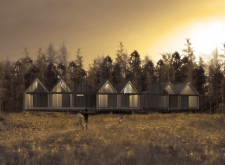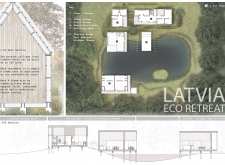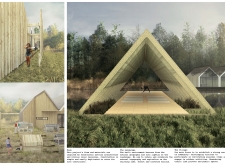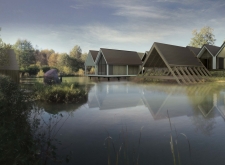5 key facts about this project
## Overview
The Latvia Eco Retreat is situated within a natural landscape conducive to tranquil living, embracing an eco-friendly ethos that integrates communal living, wellness amenities, and the surrounding environment. Drawing from traditional Latvian architectural principles while incorporating modern design elements, the project aims to create a space that promotes well-being and community interaction. The design invites visitor participation in activities such as gardening and outdoor recreation, thus fostering an inclusive atmosphere detached from the demands of urban life.
## Spatial Strategy and Community Integration
The spatial arrangement of the retreat emphasizes a village-like concept that encourages interaction among guests. Individual accommodations are designed as A-frame structures, creating a unified visual identity while ensuring functionality and comfort. Centrally located therapy rooms and shared facilities serve as communal gathering spaces, accommodating a range of wellness services, including spas and saunas. The incorporation of activity areas and meandering trails enhances connectivity between private and public spaces, promoting an agile lifestyle immersed in nature. The layout enables guests to engage actively with both the structures and the surrounding landscape, creating a meaningful connection to the environment.
## Material Selection and Environmental Considerations
The selection of materials reflects a commitment to sustainability and local resources. Local timber forms the primary construction material, minimizing transportation emissions while supporting the regional economy. Thick insulated walls enhance the energy efficiency of the structures, while traditional thatch roofing not only preserves aesthetic ties to local architecture but also contributes to insulation. The use of glass throughout the retreat facilitates visual connections to the outdoors, maximizing natural light and enhancing guest experiences. Elevated design features, such as concrete pillars, help preserve the natural landscape by minimizing land disruption and promoting ecological balance. This careful consideration of materiality and environmental factors positions the retreat as a sustainable model in contemporary architecture.






















































